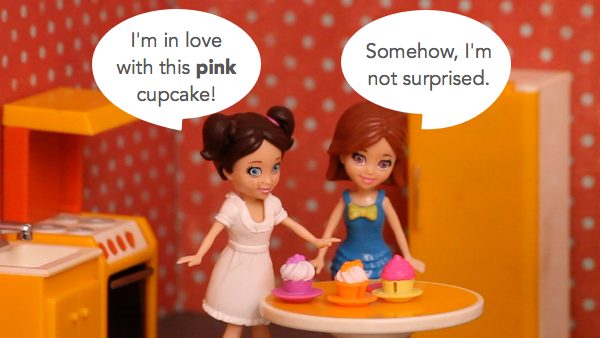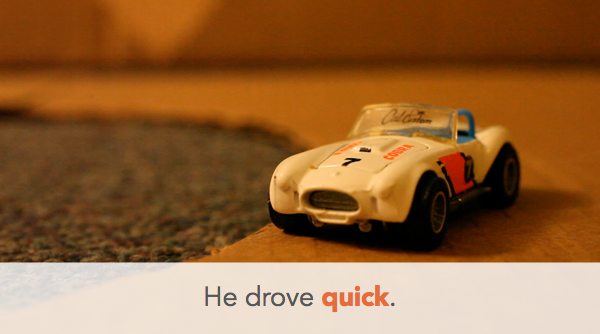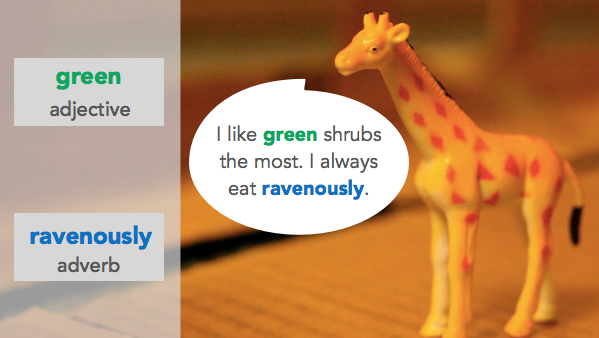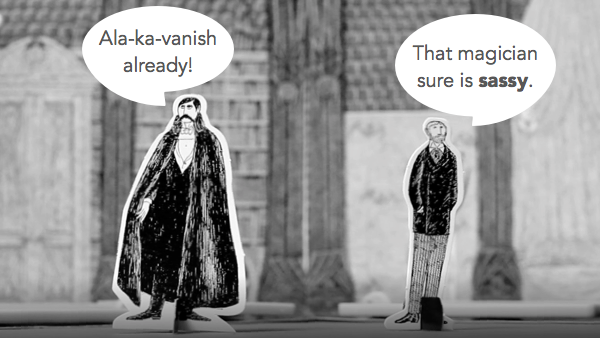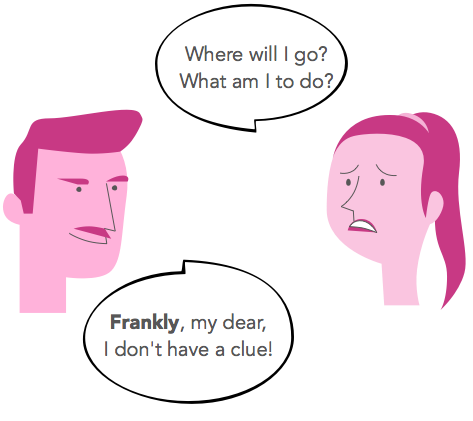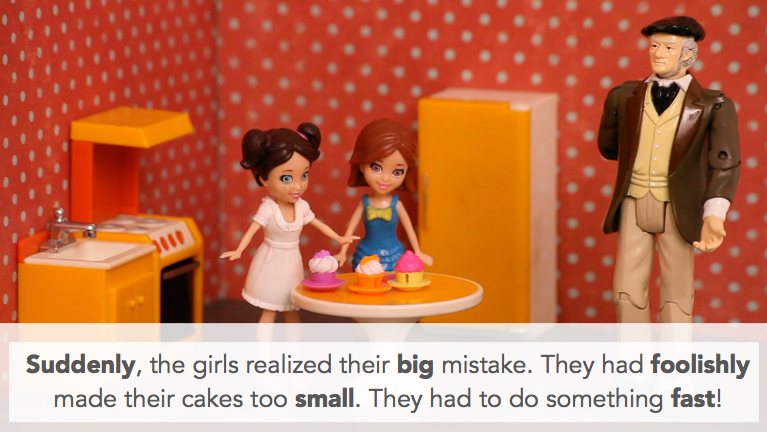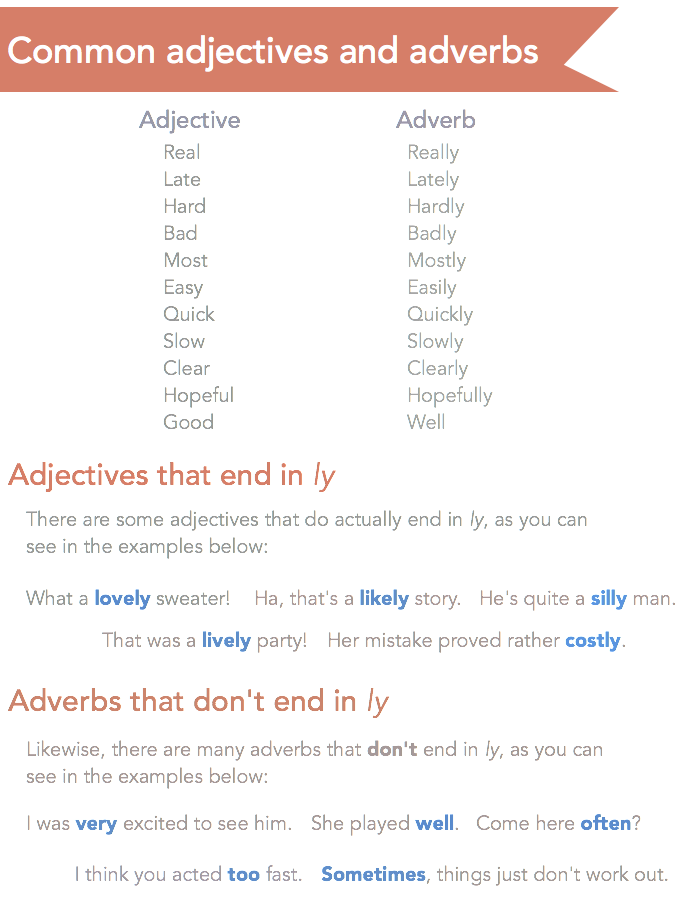Adjectives and adverbs can be confusing. Which is which? When and how do we use them? Does it even matter? To answer the last question, yes, it does matter! Knowing which words are adjectives and which are adverbs makes your speech and writing much clearer in English. So let’s have a look at some of the differences.
- What are adjectives and adverbs?
- Regular adverbs in English
- Irregular adjectives and adverbs in English
- The different types of adverbs
Learn languages at your pace
What are adjectives and adverbs?
The difference between adjectives and adverbs is fairly easy: An adjective describes a noun. They answer questions like what kind or how many. For example, red is an adjective and car is a noun. Adjectives usually go before nouns in English so we say a red car. Red is a descriptive adjective, and we’re going to focus on these today.
An adverb usually describes a verb. They answer questions like when, where and how. Quickly is an adverb and run is a verb. Adverbs can go in lots of different places in a sentence, but here we can say he runs quickly. This answers the question, How does he run? We’re going to focus mainly on adverbs that answer the how question, which are adverbs of manner.
This explanation is simple enough – especially for English teachers – but it doesn’t really tell you much in practical terms does it? Because the real question is, how do you know if a certain word should be used as an adjective or an adverb? How do you make adverbs from adjectives? And where do you put them in a sentence?
Regular adverbs in English
It’s easy to spot regular adverbs vs adjectives because they end with –ly, like quickly in the example above. To form these regular adverbs, we add -ly to the end of adjectives. So, serious becomes seriously; slow becomes slowly. A slow tortoise walks slowly. This works with quite a lot of adjectives with just small changes to the rule:
If the adjective ends with a –y, change the –y to an –i then add –ly: happy becomes happily, easy becomes easily.
- He smiled happily!
If the adjective ends in –able, –ible or –le, change the –e to a –y. We see this in words like horrible – horribly, and responsible – responsibly.
- They didn’t act very responsibly.
And if the adjective ends in –ic, add –ally. Basic changes to basically, classic changes to classically. The exception to this is public, which becomes publicly.
- She is a classically trained musician.
Irregular adjectives and adverbs in English
Some adverbs have the same form as adjective. Examples of this are fast and high.
- This is a fast car. He drives fast.
- We saw a lot of high towers. The plane flew high.
We said above that adverbs can be made by adding –ly to the adjective, but not all words that end in –ly are adverbs! Some adjectives also end in -ly, and they have the same form as the adverb. Common words like this are: early, late and daily.
- We ate an early dinner. We finished work early today.
- I read the daily newspaper. I read the newspaper daily.
We also have some adjectives that don’t have an adverb equivalent. For example: friendly, lonely and lovely. Instead of using an adverb, we can say in a … manner. The adjective remains an adjective.
- What a friendly dog! The dog behaves in a friendly manner.
Learn languages at your pace
The different types of adjectives
1. Predicative adjectives
Most adjectives come before nouns. But, sometimes adjectives come after the noun they modify, and after a verb too. This is when we are talking about a sense verb or a verb of appearance, and they are called predicative adjectives. Here they are:
- be
- feel
- taste
- smell
- sound
- look
- appear
- seem
Here are some examples of these verbs:
- London is busy.
- I feel bad about what happened.
- The cake tastes nice.
- The flowers smell sweet.
- That dog sounds unhappy.
- Gemma looks sleepy.
- The sea appears blue in some lights.
- Bob seems angry.
In all of these sentences, the adjective comes after the verb but it describes what the noun is like. English learners often make mistakes like this:
- The cake tastes nicely (this means the cake can taste something – and last time I checked, cakes don’t have mouths).
- The flowers smell sweetly (and this makes it sound like flowers have noses).
The easiest way to remember this is to think about the verb be, which we use a lot with adjectives:
- She is nice.
- The dog is happy.
- The chair is comfortable.
2. Adjective + adverb
So far, we have looked at adverbs modifying verbs, but they can also modify adjectives. Here’s an example:
- The weather is terribly hot today.
Terribly is an adverb and it is modifying the adjective hot. Here are some more examples:
- The girl is quite pretty.
- I am completely exhausted.
3. Adverb + adverb
Adverbs can also modify other adverbs, making what you’re saying more descriptive. For example:
- My dog eats incredibly loudly.
Incredibly, an adverb, modifies the adverb loudly. Some more examples:
- She spoke very quickly.
- He was walking awfully slowly.
4. Adverbs of frequency
There are six main adverbs of frequency in English which tell us how often something happens. Here they are in sentences:
- I always eat cereal for breakfast.
- I usually wake up at 7am.
- I often go to the gym before work.
- I sometimes walk to the office.
- I rarely go to bed later than 11pm.
- I never eat meat.
Other adverbs of frequency you might know are normally, frequently and hardly ever.
5. Adverbs of place
Words and phrases that tell us where something happens are often also adverbs. For example:
- He has lived in the city centre all his life.
- He still lives there now.
- Come here!
- I’ve looked everywhere for him but he’s just disappeared.
5. Adverbs of time
We have already talked about the irregular adverbs early and late. These are examples of adverbs of time; they describe when something happens. Here are some more examples of sentences with adverbs of time:
- I don’t like driving after dark.
- She finished her exam first.
- The TV show is on now and we’re missing it!
6. Adverbs of degree
We have also met some of these adverbs of degree already when we were looking at modifying adjectives and adverbs. Adverbs of degree tell us about the intensity of something. In some of the sentences above we had very, quite and completely. Here are some more examples:
- It’s rather chilly today.
- The play was absolutely terrible.
- I almost forgot to tell you.
7. Adverbs of evaluation
We can use adverbs to show our opinion of something as part of the sentence. Here are some examples:
- Unfortunately, the weather was bad.
- She didn’t want to come to the party, surprisingly.
- Incredibly, no one was hurt in the accident.
The use of adverbs in all of these sentences shows us what the speaker thinks and feels about the situation, and gives us more information about the context. We can infer, for example, in the last sentence, that the accident was quite bad and it’s amazing that no one was hurt.
So, how do you know if something is an adjective or an adverb? Does it describe a noun, or does it describe a verb, adjective or adverb? And, does it end in –ly? It’s probably an adverb. But English wouldn’t be English without a few exceptions, so try to memorise the ones we’ve talked about here, and you’ll be a long way to learning the difference between adjectives and adverbs.
Learn languages at your pace
Laura is a freelance writer and was an ESL teacher for eight years. She was born in the UK and has lived in Australia and Poland, where she writes blogs for Lingoda about everything from grammar to dating English speakers. She’s definitely better at the first one. She loves travelling and that’s the other major topic that she writes on. Laura likes pilates and cycling, but when she’s feeling lazy she can be found curled up watching Netflix. She’s currently learning Polish, and her battle with that mystifying language has given her huge empathy for anyone struggling to learn English. Find out more about her work in her portfolio.
To speak correctly and write standard English, you first need to understand the function of each word type in a sentence, including adjective and adverb. In addition, grasping the position and telltale signs between these two words is also very important to perfect your English skills.
There are a lot of misconceptions about the words “adjective” and “adverb.” The truth is, their meanings are not always interchangeable. In this lesson, we teach you the difference between these two words and show you how to use them properly.
Learn all about adjectives and adverbs with English tivi right now!
You might also like: ALL the English Grammar Basics You Need
An adjective is a word that indicates the nature, extent, range, etc. of a person or thing. It modifies nouns, pronouns, or linking verbs. Adjectives always come before the noun to be modified:
-That is my new red car.
Except for the case that the following two adjectives can come after the noun to be modified: “galore” (many, abundant, abundant) and “general” in the names of major agencies and positions:
-There were errors galore in your final test.
-UN Secretary-General
Adjectives after provocative pronouns (something, anything, anybody…)
-It’s something strange.
-He is somebody quite unknown.
Adjectives are divided into 2 types: descriptive adjectives and limiting adjectives. Descriptive adjectives are adjectives that indicate the color, size, or quality of an object or person. Limiting adjectives are adjectives indicating the quantity, distance, possessive properties, etc. An adjective does not change in person and number of the noun it modifies, except in the case of “these” and “those”.
| DESCRIPTIVE ADJECTIVE | LIMITING ADJECTIVE |
| beautiful large red interesting important colorful |
one, two first, second my, your, his this, that, these, those few, many, much |
When a descriptive adjective modifies a singular countable noun, it usually has the article.
a, an or the in front like a pretty girl, an interesting book, the red dress
– Adjectives go before the noun but after the linking verb
If in a phrase there are many adjectives that modify the same noun, the order of the adjectives will be as follows: possessive adjective or article, opinion, size, age, shape, color, origin, material, purpose. Notice that the possessive adjective (my, your, our…) or article (a, an, the) if present, always precede other adjectives. If you have used an article, do not use a possessive adjective and vice versa.
+ A silly young English man
+ The huge round metal bowl
| art/poss | opinion | size | age | shape | color | origin | material | purpose | noun |
| a | silly | Young | English | man | |||||
| the | huge | round | metal | bowl | |||||
| my | small | red | sleeping | bag |
You might also like: Adjective – Parts Of Speech – Adjective English Grammar
Adverb (preposition)
Adverbs (Adverbs) modify a verb, an adjective, or another adverb.
+ Rita drank too much
+ I don’t play tennis very well.
+ John is reading carefully
+ She speaks Spanish fluently
Usually, descriptive adjectives can be changed into adverbs by adding the suffix -ly to the adjective
+ He is a careful driver. He always drives carefully.
| ADJECTIVE | ADVERB |
| bright careful quiet |
brightly carefully quietly |
However, there are some adjectives that do not follow the above rules:
• Some special adjectives: good => well; hard => hard; fast => fast; …
-She is a good singer. She sings very well.
• Some adjectives also end in -ly (lovely, friendly…) so to replace adverbs of these adjectives, people use: in a/ an + Adj + way/ manner.
-He is a friendly man. He behaved to me in a friendly way.
The following words are also adverbs: so, very, almost, soon, often, fast, rather, well, there, too. Adverbs are divided into the following six categories:
| ADVERB OF | EXAMPLE | TELL US |
| Manner | happily, bitterly | how something happens |
| Degree | totally, completely | how much something happens, often go with an adjective |
| Frequency | never, often | how often something happens |
| Time | recently, just | when things happen |
| Place | here, there | where things happen |
| Disjunct | hopefully, frankly | viewpoint and comments about things that happen |
Adverbs often act as adverbs in sentences. In addition, prepositional phrases also act as adverbs, they include an opening preposition and the following noun to indicate: address (at home), time (at 5 p.m), vehicle (by train), situation, action. These phrases all function and are used as adverbs, and can also be considered adverbs.
Regarding the order, the adverbs with the same modifiers for a verb usually appear in the order: manner, place, time. In general, adverbs of manner (manner – tell how the action happens) are more closely related to verbs than adverbs of place and adverbs of place. associated with verbs more closely than adverbs of time.
-The old woman is sitting quietly by the fire for hours.
In terms of position, adverbs can appear almost anywhere in a sentence: at the end of a sentence, at the beginning of a sentence, before the main verb, after the auxiliary verb, but also because of that, it is a rather complicated matter. The position of the adverb can change the meaning of the sentence somewhat.
You might also like: Adverb – Parts Of Speech – Adverb English Grammar
Signs to Recognize Adjective and Adverb
Signs to recognize adjectives
- The end is “able”: comparable, comfortable, capable
-We select the hotel because the rooms are comfortable.
- The end is “ible”: responsible, possible, flexible
-She is responsible for her son’s life
- The end is “ous”: dangerous, humorous, notorious
-She is one of the most humorous actresses I’ve ever known.
- The end is “ive”: attractive, decisive, competitive
-She is a very attractive teacher.
- The end is “ent”: confident, dependent, different
-He is confident in getting a good job next week.
- The end is “ful”: careful, harmful, beautiful
-Smoking is extremely harmful to your health.
- The end is “less”: careless, harmless, breathless
-He is fired because of his careless attitude to the monetary issue.
- The end is “ant”: important, reluctant, tolerant
-Unemployment is an important interest of the whole company.
- The end is “ic”: economic, specific, toxic
-Please stick to the specific main point.
- The end is “ly”: friendly, lovely, costly
-Making many copies can be very costly for the company.
- The end is “y”: rainy, sunny, muddy
-Today is the rainiest of the entire month.
- The end is “al”: economical (tiết kiệm), historical, physical
– Instead of driving to work, he has found out a more economical way to save money.
- The end is “ing”: interesting, exciting, moving
-I can’t help crying because of the moving film.
- The end is “ed”: excited, interested, tired
-He has been working so hard today, so he is really exhausted.
Adverb recognition signs
Structural adverbs are quite simple:
Adv = Adj + -ly
Eg: wonderfully, beautifully, carelessly…
– She dances extremely beautifully.
See more at: English Grammar
Adjective and Adverb Exercises
Question 1: He answered the phone____________. .
A. sudden
B. suddenly
Question 2: There is a lot of____________interference on the line.
A. noisy
B. noisily
Question 3: Thank you for returning my call so____________. .
A. quick
B. quickly
Question 4: I am calling because the changes seem very____________.
A. importantly
B. important
Question 5: Sorry, but I can’t write that____________.
A. fast
B. fastly
Question 6: She sounded very____________ on the phone
A. angrily
B. angry
Question 7: The boy skipped____________ down the road to school.
A. happy
B. happily
Question 8: It was____________packaged and wrapped in pretty, recycled paper.
A. nicely
B. nice
Question 9: All goes____________, and he feels relaxed enough to go for a walk.
A. good
B. well
Question 10: Andy doesn’t often work____________. .
A. hardly
B. hard
Question 11: She planned their trip to Greece very____________. .
A. carefully
B. careful
Question 12: She speaks very____________. .
A. quietly
B. quiet
Question 13: Turn the stereo down. It’s too____________. .
A. loudly
B. loud
Question 14: Children should be cared for by a____________ family.
A. normally
B. normal
Question 15: Jane is____________because her job is____________. .
A. bored-bored
B. boring-boring
C. boring-bored
D. bored-boring
Question 16: Mai has lived in London for five years so she speaks____________. .
A. perfect English
B. perfectly English
C. English perfect
D. English more perfect
Question 17: Mr. Davis doesn’t work here____________. He left about 6 months ago.
A. any long
B. some long
C. any longest
D. any longer
Question 18: We didn’t go out because it was raining____________. .
A. heavy
B. heavily
C. heavier
D. heavilier
Question 19: The driver of the car was____________in the accident.
A. serious injured
B. seriously injured
C. serious injuredly
Question 20: I don’t like this coffee because it tastes very____________. .
A. strength
B. strong
C. strongly
D. strengthly
Adjective and Adverb Answer
1: B. suddenly
2: A. noisy
3: B. quickly
4: B. important
5: A. fast
6: B. angry
7: B. happily
8: A. nicely
9: B. well
10: B. hard
11: A. carefully
12: A. quitely
13: B. loud
14: B. normal
15: D. bored-boring
16: B. perfectly English
17: D. any longer
18: B. heavily
19: B. seriously injured
20: B. strong
You might also like: What are the 4 Types of Questions in English?
Subscribe to the English tivi channel on Youtube to improve your English learning skills!
Post Views: 6,361
Phrase-oriented grammar
There is no simple rule. But here is the key: in English, you must learn to recognize phrases, not just individual words. In English, phrases are often indivisible units of grammar.
In your example, «bright red» is an adjectival phrase. The two words together function as a single adjective. You think of them as one unit:
She wore a bright red beautiful dress.
If you re-ordered it, you would say:
She wore a beautiful bright red dress.
If you re-ordered it like this:
She wore a bright beautiful red dress.
that would change the meaning, since «bright» would now be an adjective modifying «beautiful red dress».
A phrasal adverb
Here is a phrase that functions as an adverb:
Paul quit smoking cold turkey.
«Cold turkey» is an adverb meaning «to quit suddenly, not gradually». How do you know? The same way you know the meaning of any individual word. «Cold turkey» is itself an element of English vocabulary, even though it’s two words long.
The adverbial phrase «cold turkey» is mainly used to describe quitting smoking. In a different context, the same two words would be interpreted as an adjective modifying a noun:
There is some cold turkey in the refrigerator.
Here, «turkey» is the simple subject of the sentence, modified by «cold».
This doesn’t mean that you couldn’t use «cold turkey» as an adverb to describe quitting something other than smoking. But if you say something like «I’m giving up potato chips cold turkey«, people will understand that you are drawing an analogy with quitting smoking. It wouldn’t make sense to say «I’m quitting my job cold turkey» because there is no analogy between quitting a job and quitting smoking. Then again, if, for some strange reason, your job was a bad habit or perhaps caused lung damage, and it was possible to gradually reduce your number of working hours, then «cold turkey» would make sense in that sentence.
Are you terrified yet?
Now that you know that there is no systematic way to tell an adjective from an adverb, because phrases in English can function like words and there are no grammatical cues in the sentence to tell you when that’s happening, is learning English starting to seem hopelessly difficult? Well, the situation is even worse than what I’ve told you so far. Here are three more difficulties.
First, the phrases are not necessarily contiguous in a sentence. Look at this:
I’ll pick you and your friends up from the airport.
«Pick up» is a phrasal verb. If you’re not used to this, you can easily think that the verb in this sentence is «pick». But «pick» means something completely different than «pick up», «pick out», «pick apart», «pick over», etc. You have to train your ear to recognize the phrase even when it’s interrupted by other words. You have to be able to do that even though «pick» can be a verb on its own, as in «I’ll pick a new flight for you and your friends.»
Second, the indivisible phrases are not completely indivisible. It’s still possible to modify individual words within them to modify the meaning of the phrase, though this is somewhat uncommon. For example, a person could say «Well, I’m sort of quitting warm turkey. My last cigarette is scheduled for Sunday.» (By the way, «sort of» is another phrasal adverb.) What’s happening is that people simultaneously perceive the phrase as an indivisible unit and as individual words modifying each other («turkey»: noun; «cold»: adjective). Inside «bright red», «red» is perceived as a noun, modified by the adjective «bright»—even though «bright red» is itself an adjective.* That’s why «bright pink», «bright yellow-green», etc., also make phrasal adjectives, and not «bright pinkish», etc.
Third, English pedagogy rarely acknowledges the way English grammar depends on phrases and analogies. For centuries, the teaching of English grammar has focused on rules, which were thought to govern individual words and how they combine to form sentences. This originated when English grammarians got their terminology and concepts from Latin, which is genuinely word- and rule-oriented. More recent work by linguists has started to take the phrasal orientation of English more seriously, but it’s still usually explained as a system of strict rules rather than the analogy-oriented way that it works in real life; and few teachers have even heard of these new systems for describing English grammar.
So, most teachers, especially teachers who are not native speakers of English, will mislead you about English grammar. They were «taught» that it’s all rules, operating on individual words, and they’ll pass that misinformation on to you. And many native speakers, having been mistaught English grammar in elementary school, will «helpfully» try to answer questions about English by telling you word-oriented rules, never saying a word about phrasal units or the role of loose analogy in combining and varying them.
Reason for hope
OK, now you know the worst of it. Now here are a few reasons why you can expect to eventually master the «unruly» phrasal grammar of English.
First, English also has a word-oriented, rule-oriented grammar. In «She wore a red dress», there are no indivisible phrases: «red» is an adjective modifying the noun «dress». This is the backbone of the grammar. The phrasal stuff combines and modifies the basic elements. After you’ve mastered the basic grammar, you start to perceive phrasal units like «bright red», «cold turkey», and «sort of».
Second, now you know about phrasal units in English. That’s a huge advantage. Now you know to learn «pick up» as a phrasal verb. Now you know not to think that «up» in «pick up» introduces a prepositional phrase—a common mistake for people whose first language is a Romance language. Just knowing that these phrases exist helps you «tune your ear» to hear them.
Third, the potential for chaos is limited by the fact that people really do communicate in English. While unruly phrasal grammar could theoretically make the language hopelessly irregular and complex, the use of indivisible phrasal units is kept in check by common patterns and customs. With experience, you’ll pick up those patterns and customs intuitively, just like a native. It’s mostly hard at first, before you’ve mastered the basic grammar and before you know that these phrases exist.
Also, while most of the world’s languages do not have a phrasal grammar like English, some do. If you’re starting from another language with this kind of grammar, like Mandarin, this aspect of English won’t be an obstacle for you. (In fact, Mandarin grammar is much more phrasal than English grammar.)
*Actually, «bright red» is only an adjective if you use it as an adjective, as in your example sentence. «Bright red» can also be an ordinary noun phrase, with «red» as the noun, if you use it that way, as in «Bright red is my favorite color.» «Bright red» as an indivisible adjectival phrase is formed by analogy with «bright red» as an ordinary noun phrase, drawing on the fact that «red» ordinarily serves as both an adjective and a noun.
Lesson 9: Adjectives and Adverbs
/en/grammar/quotation-marks/content/
Adjectives and adverbs
Adjectives and adverbs are both words that describe something. If anyone has ever asked you to describe something in detail, you probably used some adverbs and adjectives along the way. But it can be easy to mix them up and forget which is which, so it’s important to know how each one is used.
What is an adjective?
An adjective is a word that describes a noun. In other words, it tells us more about a particular person, place, or thing.
Adjectives also make it easy to understand which thing you’re talking about. In the example above, the word pink describes a particular cupcake. So pink is an adjective. If one cupcake was larger than the others, we could have said it was the big cupcake.
What is an adverb?
An adverb is a word that describes a verb. Just like adjectives, adverbs are used to add detail to a sentence. More specifically, adverbs tell us how, when, or where something happened.
In the example above, the word deeply describes how he was staring, so deeply is an adverb. In this sentence, it means he was staring in a deep way. If his staring had been weird, we could have said he was staring weirdly.
Using adjectives and adverbs
You know adjectives and adverbs are both words that describe something. But for many people, these words are also easy to mix up. Thankfully, there are some simple rules that will help you know which is which and when to use them.
Look at the context
If you’re not sure whether to use an adverb or an adjective, try to figure out what you’re describing. Remember, adjectives are used to describe nouns, which means they can explain what kind of thing you have, how many things you have, or which thing you’re talking about.
Adverbs, on the other hand, are used to describe verbs, which means they can explain how something happened, when something happened, or where something happened.
Look at the ending
You might have already noticed that many adverbs end with the letters ly. If you see a word that ends in ly, there’s a good chance it’s an adverb, not an adjective. Can you use this rule to tell what’s wrong with this sentence?
Because it doesn’t have an ly ending, you might have guessed that quick is an adjective. However, this sentence is incorrect because an adjective can’t be used to describe a verb (drove).
To make this sentence correct, we could change the adjective to an adverb: He drove quickly. Now the sentence describes how he was driving.
Look at the placement
Here’s an easy way to know where to put an adjective in a sentence. It will usually appear just before the noun it’s describing. By contrast, an adverb will usually appear right after the verb it’s describing.
Unfortunately, placement doesn’t always tell you if something is an adverb or adjective. For example, is sassy an adjective or adverb in the image below?
Even though it’s right next to a verb (is), sassy is an adjective because it describes the magician. And while adjectives are usually close to the words they describe, adverbs can move around more freely in a sentence. For example, you might see an adverb at the beginning of a sentence.
Here, frankly is an adverb, but it doesn’t describe any specific verb in the sentence. Instead, it means the entire sentence will be spoken in a frank, or direct, way. If he was more optimistic, he might have said, Hopefully, it will all work out.
Use the techniques you just learned and see if you can pick out the adjectives and adverbs below.
Adverb!
This word tells us when the girls realized their mistake. Remember, adverbs can appear at the beginning of a sentence, but you aren’t very likely to see an adjective there.
The LY ending is another clue that this is an adverb.
Adverb!
This might look like an adjective, because it’s right next to a noun. However, it’s important to see that it’s actually describing how the girls will need to act (fast), rather than how fast that something is.
Adjective!
Even though it’s not next to a noun, this word tells us more about the size of the cakes.
Adverb!
Even though this word comes before the verb it describes, it still tells us how they made their cakes. The LY ending is another clue that this is an adverb.
Adjective!
Like many adjectives, this one comes right before the noun it’s describing. This adjective tells us more about the mistake.
Common adverbs and adjectives
A lot of adjectives and adverbs are actually based on the same word, which is one reason they’re sometimes difficult to tell apart. Here’s a list of the adjectives and adverbs you’ll see the most:
You can also place an adverb between the word to and a verb. This is called a split infinitive. In the past, this was considered a serious grammatical error, but it’s commonly used and accepted today.
/en/grammar/capitalization/content/
An adverb is a part of speech (or word class) that’s primarily used to modify a verb, adjective, or other adverbs and can additionally modify prepositional phrases, subordinate clauses, and complete sentences. Put another way, adverbs are content words that provide information about how, when, or where something happens. Adverbs are also called intensifiers because they intensify the meaning of the word or words they are modifying, notes Your Dictionary.
An adverb that modifies an adjective—as in quite sad—or another adverb—as in very carelessly—appears immediately in front of the word it modifies, but one that modifies a verb is generally more flexible: It may appear before or after—as in softly sang or sang softly—or at the beginning of the sentence—Softly she sang to the baby—with the position of an adverb typically affecting the meaning of the sentence. Adverbs can modify a verb or adjective in several ways, by providing information about emphasis, manner, time, place, and frequency.
Adverbs of Emphasis
Adverbs of emphasis are used to give added force or a greater degree of certainty to another word in a sentence or to the sentence as a whole, for example:
- He certainly liked the food.
- She is clearly the frontrunner.
- Naturally, I like my chicken crispy.
Other common adverbs of emphasis include absolutely, definitely, obviously, positively, really, simply, and undoubtedly. These types of adverbs serve to bolster the part of speech they modify.
Adverbs of Manner
Adverbs of manner indicate how something is done. They are usually placed at the end of a sentence or before the main verb, as in:
- Tom drives quickly.
- She slowly opened the door.
- Mary waited for him patiently.
Other examples of adverbs of manner include quietly, fitfully, and carefully.
Adverbs of Time
Adverbs of time tell you when or at what time something is done. Adverbs of time are usually placed at the end of a sentence. They can also be used at the beginning of a sentence followed by a comma.
- The meeting is next week.
- Yesterday, we decided to take a walk.
- I’ve already bought my tickets for the concert.
These adverbs are used with other time expressions, such as days of the week. The most common adverbs of time include yet, already, yesterday, tomorrow, next week (or month or year), last week (or month or year), now, and ago.
Adverbs of Place
Adverbs of place indicate where something is done and usually appear at the end of a sentence, but they can also follow the verb.
- I decided to rest over there.
- She’ll wait for you in the room downstairs.
- Peter walked above me upstairs.
Adverbs of place can be confused with prepositional phrases such as in the doorway or at the shop. Prepositional phrases indicate where something is, but adverbs of place can tell you where something occurs, such as here and everywhere.
Adverbs of Frequency
Adverbs of frequency tell you how often something is repeatedly done. They include usually, sometimes, never, often, and rarely. Adverbs of frequency are often placed directly before the main verb:
- She rarely goes to parties.
- I often read a newspaper.
- He usually gets up at 6 o’clock.
Adverbs of frequency that express infrequency are not used in the negative or question form. Sometimes, adverbs of frequency are placed at the beginning of a sentence:
- Sometimes, I enjoy staying at home instead of going on vacation.
- Often, Peter will telephone his mother before he leaves for work.
Adverbs of frequency follow the verb to be:
- He is sometimes late for work.
- I am often confused by computers.
Adverbs Modifying Adjectives
When adverbs modify an adjective, they are placed before the adjective:
- She is extremely happy.
- They are absolutely sure.
However, do not use very with adjectives to express increased quality of a basic adjective, such as fantastic:
- She is an absolutely fantastic piano player.
- Mark is an absolutely amazing lecturer.
You would not say, «She is very fantastic,» or «Mark is a very amazing lecturer.»
Forming Adverbs From Adjectives
Adverbs are often formed by adding -ly to an adjective, such as:
- Beautiful > beautifully
- Careful > carefully
However, some adjectives don’t change in the adverb form, such as fast and hard. Many common adverbs like just, still, and almost do not end in -ly. Good is probably the most important example. The adverb form of good is well, as in:
- He is good at tennis.
- He plays tennis well.
In the first sentence, good is an adjective that modifies the pronoun he; while in the second, well is an adverb that modifies plays (explains how he plays tennis). Additionally, not all words that end in -ly are adverbs, such as friendly and neighborly, which are both adjectives.
Distinguishing Between Adverbs and Adjectives
Sometimes the same word can be both an adjective and an adverb. To distinguish between them, it is important to look at the context of the word and its function in a sentence.
For instance, in the sentence, «The fast train from London to Cardiff leaves at 3 o’clock,» the word fast modifies and comes before a noun, train, and is, therefore, an attributive adjective. However, in the sentence, «The sprinter took the bend fast,» the word fast modifies the verb took and is, therefore, an adverb.
Interestingly, -ly is not the only suffix that can be added to the end of a word to change its meaning or be used by both adjectives and adverbs. Additionally, -er and -est can combine with adverbs in a much more limited way wherein the comparative form of an adverb is likely to add more or most to the beginning of the adverb phrase rather than adding an -er or -est.
It’s important to refer to context clues when hints like the addition of an -ly or the word most to accompany a word doesn’t tell you whether it is an adjective or adverb. Look to the word that is being emphasized. If the word being emphasized is a noun, you have an adjective; if the word being emphasized is a verb, you have an adverb.

